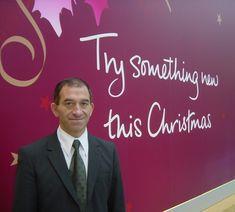

The Bristol Business School pooled their expertise in developing enterprise, understanding business strategy, product development and organisation cultures and behaviours with Jo Ouston & Co. They in turn contributed their expertise in releasing and developing creative talents the students never imagined they possessed. The creative content included everything from improvisation and story telling to design and visual art as well as exploration of sound and its impact - topics not generally on the retailer syllabus.
One graduate of the programme (who subsequently went on to masters level), Dr Theresa Huxley, describes the challenge of having to submit assignments for the diploma and simultaneously achieve non-negotiable business targets as “by far the biggest challenge I have ever experienced”. Sainsbury’s took a significant risk in investing money, management time and employee energy in this project, while the Bristol Business School and Jo Ouston & Co made a major intellectual investment. Was it worth it, for the students, for Sainsbury’s, and for their customers and suppliers?
A lot of interesting issues emerged, like whether creativity can be taught, and, if it can, is it relevant only for people in obviously creative functions like new product development and marketing? The experience of Sainsbury’s’ successful diploma holders is that (at least on the Bristol model), yes, it can be taught, or more exactly, a person’s access to creativity can be taught, and certainly its application.
And no, the benefits are emphatically not confined to the obvious functions.
But the crunch question Sainsbury’s wanted to answer, and the one facing any other companies thinking of following their path, is: how far can this sort of programme produce clear, quantifiable business benefits?
Sam Memour, retail events manager, points out that “assignments were closely linked to Sainsbury’s operations, and each one required students to reflect on how the theoretical learning could be applied to the workplace”.
Cathy Port, category product manager, remarks on the impact on departmental work of the lessons absorbed on the course: “Techniques I had learned have been observed by colleagues and adapted by them for their own situations. Creativity seems to breed creativity.” Huxley, from her technical vantage point, believes the course “provides a model which successfully combines technical expertise with the ability to think creatively. This in itself has a significant business benefit since it streamlines innovation and makes it faster, simpler and more cost effective.”
Memour cites how one module prompted a review of his department’s Christmas roadshows: “By delivering these in a more creative way, we removed £500,000 from the seasonal events budget.”
Sales have increased 40 per cent in seasonal events through improvisation techniques learned on a module dealing with improvisation and storytelling.
The organisers claim this is no a wild-blue-yonder project, Eureka moments may result, and gratifying initiatives like Sainsbury’s “Try Something New” campaign are important. “I believe,” Port says, “that as a result of the creativity course we have been able to see more possibilities in ‘Try Something New’. The initiative seems to have momentum over a wider area of the company’s business.”
Involvement in this course demonstrates “an approach to creativity, risk taking, being flexible and open to new ideas. The Try Something New campaign related both to products and to ways of working,” she said.
It is the sustained application of innovative thinking to every detail of how a company works, as well as to what it sells, that can contribute most to business performance, Sainsbury’s has found.
For example, the simple idea of issuing name badges to all colleagues has encouraged more interaction and verbal communication and email-free days have pushed the same idea further. Huxley’s department initiated the team breakfast meeting, to encourage trial of new recipes and generate creativity by giving the team time together outside the normal routine of the day. This has been such a success that other departments have adopted it.
Memour was inspired by the design and arts module to replace briefing packs with an intranet site (saving £100,000 on print). “No meeting Fridays” encourages staff members, freed from day-to-day issues, to visit stores or suppliers, or to spend time on strategic plans.
Huxley, building on the technical fact that white seedless grapes left on the vine until light amber deliver an exceptionally sweet eat, “had the confidence to launch the golden grape, which I believe has set an industry trend”. The produce team have also produced a set of visual guides for colleagues, to maintain the quality of in-store displays and promote sales. And so the examples go on.
Suppliers have benefited too, and partnerships strengthened, Sainsbury’s says. The higher profile generated for the fresh produce division by its buzz of creativity has done wonders for networking.
“Some of our primary growers are selling larger proportions of their production to Sainsbury’s by also supplying our prepared, frozen and chilled areas,” says Huxley. “For example, primary peach and nectarine growers now serve us with fresh peaches and also supply raw materials for our prepared fruit salad manufacturers. The overall effect is that we all work closer together and benefit from economies of scale.”
Memour is confident that the course has delivered a significant return on investment: “I have been able to apply lessons learned and principles absorbed to my roles within Sainsbury’s on many occasions.”
Port has also found valuable spill-over effects, for example in teamwork: “Now I feel I can better manage the different personalities/strengths/weaknesses across my team to be more effective through what I learnt during my MA.”
Phil Kirk, the Business School course director has found the process of partnering tremendously exciting. Kirk says: “Bringing the three cultures together, to convert ideas into action has been a terrific achievement calling on our own creativity and relationships to enable an exceptional experience for the students and we have all gained through the process.”



